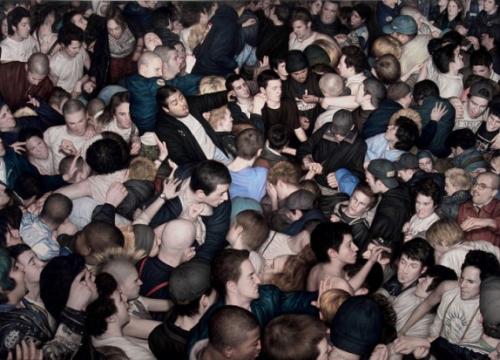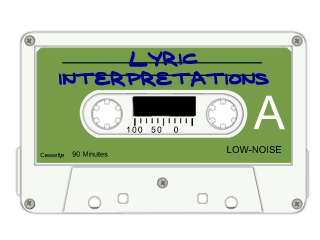Musical Mythbusting: The Origins Of The Pogo Dance

Ever notice that whenever some ancient artifact from the Stone Age gets unearthed in some archaeological dig, they always explain it as having some religious significance? It's always an idol, or part of a religious ritual, or an altar to make sacrifices, or something else in that vein. We get this picture over time that everybody from 4000 years ago spent all their time in church, to the neglect of tending crops, building houses, and raising children.
They'll do the same thing with all the artifacts from our own time. Archaeologists in the year 6000 will be pawing through our landfills going:
- "What were all these computers for?"
- "Religious purposes. They worshiped electricity."
- "Found some dice."
- "Ah, yes! These were used by priests to divine the will of the Gods."
- "Um... OK. Here's some LOLCat pictures."
- "They must have worshiped cats, too."
- "Well, here's a microwave oven..."
- "Religious use. They used it to offer burnt sacrifices."
- "Ah, could it be perhaps they just used it to cook food so they could, you know, eat?"
- "Shut up! Religious use."
So it is with our understanding of the trappings of music subcultures. It will be really hilarious when they get to the punk rocker mohawk: "Hungry concert attendants used their hair to skewer marshmallows and hot dogs to roast over an open fire at outdoor concerts. They also served as a defensive weapon. Two punk males competing for the affection of a female would charge each other head-down, locking their spiked hairdos together in a struggle for dominance."
Take the famous pogo dance. We all know that early fans of punk rock (and sometimes new wave) would dance in place by hopping up and down like a pogo stick. What isn't clear, and is therefore subject to all kinds of fancy half-baked theories, is why they did this.
- This source claims that Sid Vicious invented the pogo because he couldn't dance.
- Wikipedia claims that Vicious invented the pogo also, but has conflicting theories that he was threatening people with it, that he was restricted by a leather poncho, or that he was hopping up and down because he couldn't see the band onstage.
- This source casts its lot with the Sid-Vicious-couldn't-see-the-stage theory.
- Here's Debbie Harry being a little too literal about it.
- However, some fans, such as this one, insist that Ringo Starr was the first to dance the pogo in 1964!
Oh stop! We can't take this anymore!
Gather round, children, and let's explain THE TRUTH ABOUT THE POGO DANCE as clearly as we can:
1. You have a new underground music style that's sweeping the world, OK?
2. But because it's still underground, it's not a big-ticket style where your band can fill a stadium. Hence, you are consigned to tiny bars and basements.
3. As a result, your have something like 300 fans packed into a space the size of a motel room. Are you all still with us? There's no room, you can barely move without bumping into the band.
4. In addition, your audience is very youthful (hence, very energetic), and your music style is raw, energetic, violent, thrashing, high-energy.
5. As a result, you're packed in like sardines shoulder to shoulder while being blasted with high-energy, aggressive music. You're pumped up and yet restricted at the same time. There's no room on any side of you, so the only way to move is up and down. It's that, or stand there like a row of cornstalks.
Now then, from there it's only logical that moshing derives from the pogo. Because as more punk rock fans began to take to the pogo, more incidents occurred where uncoordinated pogo-ers jumped askew and crashed into each other. But it was nothing personal, everybody treated it as an expected thing because you're all getting claustrophobia.
That's it, that's all there is to it. Go forth, armed with this new knowledge, and conquer urban legend. And for further music mythbusting, check out our post on False Music Cliches.

 Forgotten Weird Music Videos of the Ancient 80s | vol 1
Forgotten Weird Music Videos of the Ancient 80s | vol 1  Let’s Chase Taylor Swift Rumors
Let’s Chase Taylor Swift Rumors  When the Beatles Touched Off a Movie War
When the Beatles Touched Off a Movie War  When Mike Bloomfield Composed a Soundtrack For Andy ...
When Mike Bloomfield Composed a Soundtrack For Andy ...  Yet Another List of Bad Song Covers
Yet Another List of Bad Song Covers  Why Does Everybody Pick On Liberace?
Why Does Everybody Pick On Liberace?  Trainspotting Soundtrack Revisited : One of the Best...
Trainspotting Soundtrack Revisited : One of the Best...  Nicki Minaj and Megan Thee Stallion: Bringing Back t...
Nicki Minaj and Megan Thee Stallion: Bringing Back t...  Quirky Songs About Los Angeles
Quirky Songs About Los Angeles  Penguin Pete’s Obligatory Penguin Cafe Orchestra Post
Penguin Pete’s Obligatory Penguin Cafe Orchestra Post  Heart | How Bad Are Those Animals?
Heart | How Bad Are Those Animals?  That Time Ronnie James Dio Saved Black Sabbath’s Bacon
That Time Ronnie James Dio Saved Black Sabbath’s Bacon  What is a Left Hand Path? - Entombed and Swedish Dea...
What is a Left Hand Path? - Entombed and Swedish Dea...  Song Analysis Corner: Convoy (1975)
Song Analysis Corner: Convoy (1975)  What’s Up With Margaritaville?
What’s Up With Margaritaville?  This Album Links Duran Duran, Andy Warhol, and Kurt ...
This Album Links Duran Duran, Andy Warhol, and Kurt ...  Your Back-To-School Playlist
Your Back-To-School Playlist  Cucumber Castle | the other Bee Gees Movie
Cucumber Castle | the other Bee Gees Movie  Danny Elfman Scores New Film; Other Movie Weirdness!
Danny Elfman Scores New Film; Other Movie Weirdness!  Sparks Is Not Crying in Their Latte
Sparks Is Not Crying in Their Latte  Travis Scott : Rapper, Cannabis Entrepreneur, Filmmaker
Travis Scott : Rapper, Cannabis Entrepreneur, Filmmaker  Anders Runestad – Author and Music Blogger
Anders Runestad – Author and Music Blogger  What If They Really ARE Giants?
What If They Really ARE Giants?  Prince’s Underrated Under the Cherry Moon
Prince’s Underrated Under the Cherry Moon  Six Degrees of Blondie
Six Degrees of Blondie  Six Degrees of: Adam and the Ants
Six Degrees of: Adam and the Ants  Discovering Beat-Club | Vintage West German Music Show
Discovering Beat-Club | Vintage West German Music Show  Eurovision Contest Winners part 2
Eurovision Contest Winners part 2  Song Analysis Corner: Snoopy vs. the Red Baron | The...
Song Analysis Corner: Snoopy vs. the Red Baron | The...  Eurovision Contest Winners part 1
Eurovision Contest Winners part 1  KISS SUXX!
KISS SUXX!  You Haven’t Met Your Last Reefer Man
You Haven’t Met Your Last Reefer Man  Ruth Underwood and the “Zappa sound”
Ruth Underwood and the “Zappa sound”  Catchy Commercial Earworms | vol 2
Catchy Commercial Earworms | vol 2  Song Analysis Corner: “Trouble Every Day” | Frank Zappa
Song Analysis Corner: “Trouble Every Day” | Frank Zappa  Blues Music For Your Great Recession
Blues Music For Your Great Recession  We Can Fix America If We Just Bring Back Schoolhouse...
We Can Fix America If We Just Bring Back Schoolhouse...  Song Analysis Corner: Istanbul (Not Constantinople)
Song Analysis Corner: Istanbul (Not Constantinople)  Music To Shoot Down UFOs To
Music To Shoot Down UFOs To  Are You Ready For AI Music?
Are You Ready For AI Music?  How Dreary Was 1970s Adult Contemporary?
How Dreary Was 1970s Adult Contemporary?  I Just Called To Say Stevie Wonder's Song Deserved a...
I Just Called To Say Stevie Wonder's Song Deserved a...  "Knock On Wood" | The Real Song To Remember From Cas...
"Knock On Wood" | The Real Song To Remember From Cas...  Dr. Dre's Not Gonna Take This Anymore
Dr. Dre's Not Gonna Take This Anymore  Apache - The Shadows | A Surf-Rock Safari
Apache - The Shadows | A Surf-Rock Safari  New Year : New Music Artists You (Probably) Haven't ...
New Year : New Music Artists You (Probably) Haven't ...  Song Odyssey | I Put A Spell on You
Song Odyssey | I Put A Spell on You  KMart and S.S. Kresge | Music Mystery?
KMart and S.S. Kresge | Music Mystery?  Did I Ever Introduce You To Horrorpunk?
Did I Ever Introduce You To Horrorpunk?  Song Analysis Corner : The Coffee Song
Song Analysis Corner : The Coffee Song  Duran Duran Finally Got Inducted
Duran Duran Finally Got Inducted  That Time Taylor Swift Broke Ticketmaster
That Time Taylor Swift Broke Ticketmaster  Parody Songs and Lawsuits | Of Interest To Aspiring ...
Parody Songs and Lawsuits | Of Interest To Aspiring ...  Worst Band Spats
Worst Band Spats  Rock and Roll Bookshelf | Corey Taylor's Seven Deadl...
Rock and Roll Bookshelf | Corey Taylor's Seven Deadl...  Lizzo, the Flute, and Racist-Sexist Republican Fallout
Lizzo, the Flute, and Racist-Sexist Republican Fallout  Remembering Coolio | RIP Coolio 2022
Remembering Coolio | RIP Coolio 2022  Buy the Soundtrack, Skip the Movie : Singles (1992)
Buy the Soundtrack, Skip the Movie : Singles (1992)  Emmy Awards 2022 | Lyric Interpretations' Hot Takes
Emmy Awards 2022 | Lyric Interpretations' Hot Takes  How The Smothers Brothers Were Too Daring For 1969 TV
How The Smothers Brothers Were Too Daring For 1969 TV 